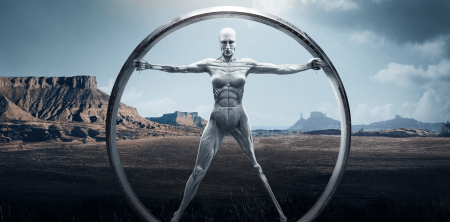In Television of the Anthropocene Part I (that I wrote exactly a year ago), I introduced the idea of the Television of the Anthropocene, and I suggested that ‘the re-emergence of sci-fi, fantasy, and post-apocalyptic genres and generic hybrids on television that address questions about human and non-human futures was unsurprising and was in line with the social and cultural status of the television as the dominant medium of storytelling’ (Palatinus 2017). I suggested thinking about television through the ‘AnthropoScreen’, denoting both a temporal/epochal positioning of the medium as well as a political ecology of the screen where we’re dealing with a ‘plethora of images’ relegated to the Anthropocene – narratives, figurations, cultural ideas produced and disseminated via the converging media of literary fiction and television, that engage with the beginning and the end of human future as we know it’ in programmes like The 100 (CW, 2014-), Incorporated (Syfy, 2016), Into the Badlands (AMC, 2015-), The Expanse (Syfy, 2015-), Zoo (CBS, 2015-), Helix (Syfy, 2014-2015), Extant (CBS, 2014-2015) and of course The Walking Dead (AMC, 2010-).
In that text, my focus was primarily on post-apocalyptic scenarios because of their figurations of catastrophe through climate change, nuclear endgames or pandemic outbreaks, resulting in an ecosystem where human existence is relativised to an extreme and where humans learn to adapt to a radically changed environment. To negotiate the nexus between the epochal and conceptual implications of the AnthropoScreen, it will be essential at one point that we rethink the role of ‘television-as-medium’, and consequently, the role of media, similarly to that of humans, in a changed ecosystem, with special attention to the ways media themselves have become an ecological factor and a framework through which we negotiate post-Anthropocene existence (Maxwell and Miller, 2012; Parikka, 2015). Still, I would like to continue now with considerations of television’s role in the circulation of posthuman sensibilities and of cultural imaginaries of a post-singularity world.
Over the past years, there’s been an emergence of film and television texts (Ex Machina Garland, 2014), Automata (Ibanez, 2014), Lucy (Besson, 2014), Transcendence (Pfister, 2014), Blade Runner 2049 (Villeneuve, 2017) or on TV Person of Interest (CBS, 2011-2016), Humans (Channel4/AMC, 2015-, based on the Swedish original Real Humans, SVT, 2012-2014), Extant (CBS, 2014-2015), Almost Human (Fox, 2013-2014), Westworld (HBO, 2016-), etc.) revolving around the advent of intelligent machines and humanoid robots that not only interact with humans and facilitate their everyday living by becoming their prosthetic supplements, but also gain consciousness and sentience, and are able to emulate human behavior to such an extent that the thin line between human and machine becomes penetrable. Such non-organic organisms are then frequently depicted not only as humans’ Other, as projections of our fears and anxieties about our own improved (cognitively and physiologically enhanced) selves predicated purely on objective-driven logic, efficiency and objective-focused operations, but, on the other hand, also as those that indirectly highlight the ineffable, unnamable qualities (or at least the challenges the explication of these qualities entail) that make us ‘human’.
These narratives habitually mobilise post-Anthropocene scenarios that entail the repositioning of the human in a changed ecosystem. As it was argued before, the Anthropocene denotes an epoch characterized by the ‘human dominance of biological, chemical and geological processes on Earth’ (Crutzen and Schwagerl, 2011). If the Anthropocene implies human becoming a force shaping both organic and inorganic matter, post-Anthropocene would refer to a subsequent near-future time when the existing societal hierarchies come under question through narratives that repurpose the ‘classic tropes of technophobia, post-colonial and post-capitalist discourses, social polarisation and totalitarianism, bio-power, genetic engineering and environmentalism, in the context of perpetual war and a culture of paranoia’ (Palatinus 2017).
AI and humanoid machines have been populating science-fiction both on paper and on the screen for a long time. While acknowledging the historical legacies of classical narratives that have by now attained a cult status (from 2001 A Space Odyssey (Kubrik, 1968) to the Star Trek franchise (NBC, 1966-), Blade Runner (Scott, 1982), the Terminator franchise and Battlestar Galactica (2004-2009, Sci-Fi Channel), films and television from the past decade are also set apart from that legacy: Ex Machina, Blade Runner 2049, Westworld, Almost Human, Extant and Humans not only negotiate ways for the coexistence of human and nonhuman species in a post-singularity ecosystem, they call attention to the a peculiar from of ‘extimity’ (cf. Miller, 2008) – the displacement and de-humanisation of human otherness via machine. Extimity in this regard would refer to a constant bouncing between the assertion and disavowal/revocation of human(like) intimacy between humans and the ‘things’. Given the versatility of both the symbolisations and conceptualisations of AI, these programme texts also ask – what exactly do we mean by it? And aren’t we expanding its notion a bit too broad to include just about everything, from androids to machine learning to the very set of algorithms that make the positing of AI possible in the first place? And what is the correlation between ‘AI a la fiction’, and real-life applications?
The past decade has seen a proliferation of cultural ideas depicting intersections between human and non-human (machine and / or animal) species. Among these, accounts of the accelerating capabilities of intelligent machines (and of machine-intelligence), their purpose, the range of their possible applications, and opinions about the ways these imminent changes will have impacted human life in the near-future have been rather divisive. On television, Person of Interest (CBS, 2011-2016), Extant, Humans and Westworld exemplify stipulations of the changes technological acceleration and the arrival of machines with human-like intelligence will have brought about. These ideas tap into current discourses on post- and trans-human futures as well as into the cultural legacies that representations of the future draw on (Jameson, 2005, Roden 2014). Ray Kurzweil offers a celebratory approach to the techno-utopian and techno-deterministic transformation of humans into ‘spiritual machines’ (Kurzweil, 1999), and anticipates that technological singularity, the merger of human technology with human intelligence, will eventually result in our ability to transcend the limitations of our biology and our physical bodies. The synths of humans offer a vision of just that, especially through the lead character of Leo Elster (Colin Morgan), a part synth (and the son of David Elster, the creator of conscious synths) who features significant prosthetic supplementation to his brain, which he needed after an accident.
Glen Mazis suggests we think of the human and the nonhuman in terms of a ‘relation-ship’ (2008), acknowledging, however, that recognising machines as ‘having a personhood’ would mean calling into question ‘another absolute divide to which we cling – the absolute difference between the animate and inanimate’ (242). This becomes a recurring trope on TV, with the anthropomorphic characters of the Machine in Person of Interest, and in Almost Human through John Kennex’s (Karl Urban) initial reluctance to accept his own prosthetic limb, and to trust and bond with Dorian, a synthetic police robot assigned to him as a partner.
Rosi Braidotti contemplates the possibility of that when she calls for the repositioning of the foundation of critical posthumanism (2013) and assumes ‘the primacy of intelligent and self-organizing matter (2018). Her agenda here is less about a radical suspension of obvious binaries (body-mind, organic-inorganic, embodiment-embrainment, nature-culture), but rather an attempt to highlight their continuity. She explains that the posthuman ‘is normatively neutral and it does not automatically point to the end of the species’, but rather, as a figuration, it is ‘both situated and partial – it does not define the new human condition, but offers a spectrum through which we can capture the complexity of ongoing processes of subject-formation’ (2018).
While Nick Bostrom’s techno-skeptical embrace of humanity through transhumanism reinscribes human(istic) hierarchies via maintaining belief in the perfectability of human through technological enhancement (2014),[1] Katherine Hayles’ reminds us that the cultural imaginaries of nonhuman otherness also constitute a political agenda that moves beyond binary oppositions (1999). Opening up further dimensions and configurations of animate and inanimate materialities in contemporary art, Barbara Stafford explores of the move from communicable matter to the (re-)emergence of ‘ineffable’ entities encompassing ‘living technology’, ‘technologies of the extended mind’, ‘bio-fictions’ and ‘multispecies intra-actions’ (2016). This ineffability is what underlies the question of sentience, suffering and the ability to create memories and snap in and out of ‘being awake’ or ‘being in a dream’ in the case of the hosts of Westworld, and we see the same ineffability being played out (and its significance being played down) in the scene where Niska (Emily Berrington) in Humans appears before a tribunal to determine whether she’s conscious, and whether as a conscious being (not a thing!) she (notice the female pronoun used interchangeably with the neuter pronoun throughout the series) is entitled to a human trial for a murder she committed in self-defense.
Niska’s outburst (that results in her killing a human) is triggered by her being ‘forced’ to work as a sexbot and literally experiencing those encounters as rape. The accumulated pain and repressed memories of humiliation and direct objectification in the hands of (male) humans – who in fact think of Niska as an object, a sex toy that ‘functions’ and ‘performs’ algorithmically, according to scripted response loops, without having the ability to know and do anything else (that is, to have an awareness and comprehension of alternatives outside of the perceived reality of her programming). She is denied the ability to ‘feel’, and as a consequence to experience real pain and suffering. Her exclusive place is that of submission, without the possibility of even having the concept of preference for what registers as pleasurable, arousing or tender, and consequently without the ability to take initiative. For the visitors of the brothel, Niska is an ‘it’ rather than a ‘she’. Abuse, for Niska, therefore does not simply amount to the physical and psychological trauma of the forced intercourse. But rather, by being reduced to mere instrumentality, the abuse is the refusal to acknowledge her as a life-form. from her reduction to mere instrumentality, the refusal to acknowledge her as a life-form. Laura (Kathrine Parkinson) and her family are some of the few humans who advocate the acknowledgement of synth sentience and try to emancipate them via forms of familial intimacy (their house synth Mia/Anita (Gemma Chan) becoming more like a family member). But even within this context, the initial intimacy is turned extimate, when we witness a bracketing-out of the human-like qualities of the synths when Laura’s husband has sex with Anita and then orders her to delete all memories of the intercourse.
We see similar displays of abuse in Westworld: the bracketing-out of agency on the part of the hosts, and the suspension of responsibility on the part of the guests is one of the principles on which the theme park operates, a feature that also becomes its key selling point. The memories of the hosts are deleted every time they reach the end of their scripted narratives so they can go back and relive the same experiences without having memories of them. As one of the technicians responsible for the maintenance of the hosts remarks, “Can you imagine what would happen if the hosts remembered what the guests do to them? (…) We give them the concept of a dream, mostly nightmares.”
As we have seen, television’s concern is not so much (or no longer) the mechanisation – more particularly the ‘machinisation’ of the human, but quite the contrary, the ‘humanisation’ of machinic entities. This, of course, also necessitates the recognition of the fact that such forms of humanisation or ‘anthropomorphisation’ are as old as any form of symbolisation, and clearly have to do with psychological imperatives that lie at the core of (human) subjectivity, and the affective dimension which television has always been prone to enhance. But what happens if we? suggest that what ‘articulations of the human via machines’ really entails is not so much, or not only, a merger of machine and human in a continuity that dismantles demarcations via disembodied and re-embodied forms of subjectivity, but rather an abstraction and algorithmisation of the human, and its replication and emulation via machine?
This of course is just one avenue of the many: humanoid machines have been around on television for a very long time. What’s more interesting, and more pressing today, is the postulation of intelligent / sentient machines that don’t simply emulate human qualities but take on a consciousness, intelligence, cognitive and perhaps even emotional traits akin to subjectivity and, consequently, agency that is comparable to those of humans. These programme texts ask: what if the ‘post’ in post-human refers not only to an irreversible temporality (what comes after humans, as a further evolutionary step, as the marker of end of human history as Kurzweil defines singularity)? What if the post in post-human refers to a ‘beyond’ – to an ontological form that human reason cannot yet fathom or stipulate? What if the post-human, the non-human, the machinic has always figured as the articulation par excellence of the human – by way of a negative dialectic? A true (re-)embodiment of that which the human is not (but hopes to be)? A sense of becoming – always-already en-route to its own transcendence? There seems to be a disconnect between the techno-scientific optimism of transhumanist philosophies (and the transhuman ethos in general), and popular renditions and projections of the same perceived futures in various forms of media. From dystopian novels to film and television to video games – and even to social media, there’s multiple visual renditions circulating (both generating and challenging ideologies) about post-human and/or transhuman ecologies. They call attention to the demise of our natural environment and depict said demise as being a necessary and inevitable result (by way of both environmental exploitation as well as the enhancing and broadening of social polarisation via exploitative labour and the increasing corporatisation of structures like healthcare, agriculture, communications technologies, education, etc.) of the very technological acceleration that (is supposed to) make a transhuman future possible.
In actuality the prominence of accelerationism (the ideology-turned-myth of steady and sustainable progress towards a self-perfecting network of systems that gradually suspend the necessity of human intervention, thus eventually disengaging /disabling human agency in the management of interconnected ecosystems) appears to be the drive dictating the tempo of research and development, using various types of media to promote their agenda and to bring the public to their sides, with soaring funding opportunities embedded in the self-serving mechanisms of the system. Film, television and video games offer a significantly different take on the question of accelerationism: the scenarios about the ways our techno-deterministic futures might play out vary, of course, but the one sentiment most of these cultural narratives have in common is the underlying skepticism, or even downright apocalypticism, about the advent of singularity.
As a consequence, the above examples inscribe themselves into a history of similarly-themed sci-fi narratives, but are set apart from them in peculiar ways: on the one hand, just like their intertextual predecessors, these narratives mobilise the old trope of technology as a threat to human life, they subvert utopistic techno-positivism and the absolutisation of big data that have become trend-setting after the algorithmic turn (Uricchio, 2011). On the other hand, they highlight a number of urgencies that have become paramount in critical discourses on technology, AI, disembodied and re-embodied intelligence, the technological mediation of cognitive processes and data. Are we to subscribe to post-apocalyptic warnings about sentient machines wiping humanity out, or are we to embrace a (Kurzweilian) utopia where humans morph into machine-enhanced cyborgic posthumans that live forever? What we witness, rather, is television’s commentary on the gradual move through the reification of Darwinian evolutionary logic, from par excellence manifestations of the Deleuzean bodies without organs, of disembodied consciousness, to the inexplicable evolution of self-replicating, self-organizing humanoid machines.
David Levente Palatinus is Lecturer in Media and Cultural Studies and founder of the Anthropocene Media Lab at the University of Ruzomberok. His research moves between and across visual studies, digital media, and cultural theory. He has worked and written on violence in serial culture, medicine and autopsy, autoimmunity and war, and digital subjectivity in the Anthropocene. He is co-editor of the ECREA section of Critical Studies in Television Online, and sits on the editorial board of Americana – E-Journal of American Studies (Hungary) and Rewind: British and American Studies Series of Aras Edizioni (Fano, Italy). He is co-editor of the volume Crime and Detection in the Age of Electronic Reproduction (forthcoming, Americana Ebooks). His book Spectres of Medicine: The Ethos of Contemporary Medical Dramas will be published next year by Aras Edizioni (Italy).
Works cited:
Bostrom, Nick. Superintelligence: Paths, dangers, strategies. Oxford: Oxford University Press. 2014.
Braidotti, Rosi: The Posthuman. Cambridge: Polity, 2013.
Braidotti, Rosi. “A Theoretical Framework for the Critical Posthumanities.” Theory, Culture & Society, May 2018, doi:10.1177/0263276418771486.
Crutzen, Paul and Christian Schwagerl. ‘Living in the Anthropocene: Toward a New Global Ethos.’ Yale Environment 360, 2011.
Hayles, Katherine. How We Became Posthuman. Virtual Bodies in Cybernetics, Literature and Informatics. Chicago: The University of Chicago Press, 1999.
Jameson, Fredric: Archeologies of the Future. Verso, 2005.
Kurzweil, Ray: The Age of Spiritual Machines. Viking Press, 1999.
Maxwell, R. and Toby Miller. Greening the Media. Oxford University Press, 2012.
Mazis, Glen A. Humans, Animals Machines. Bluring Boundaries. State University of New York Press, 2008.
Parikka, Jussi. A Geology of Media. University of Minnesota Press, 2015.
Palatinus, L.D. Television of the Anthropocene Part I. https:///television-of-the-anthropocene-part-i-by-david-levente-palatinus/.
Roden, David. Posthuman Life: Philosophy at the Edge of the Human, London: Routledge, 2014.
Stafford, Barbara. “From Communicable Matter to Incommunicable ‘Stuff’: Extreme Combinatorics and the Return of Ineffability,” in Ineffability: An Exercise in Comparative Philosophy of Religion, ed. By Timothy D. Knepper and Leah E. Kalmanson [Springer International Publishing AG, Cham, 2016]. PP
Uricchio, William. “The Algorithmic Turn. Photosynth, Augmented Reality and the Changing Implications of the Image.” Visual Studies, Vol 26, No.1, March 2011, 25-35.
Footnotes:
[1] Bostrom, Nick. Superintelligence: Paths, dangers, strategies. Oxford: Oxford University Press. 2014.







